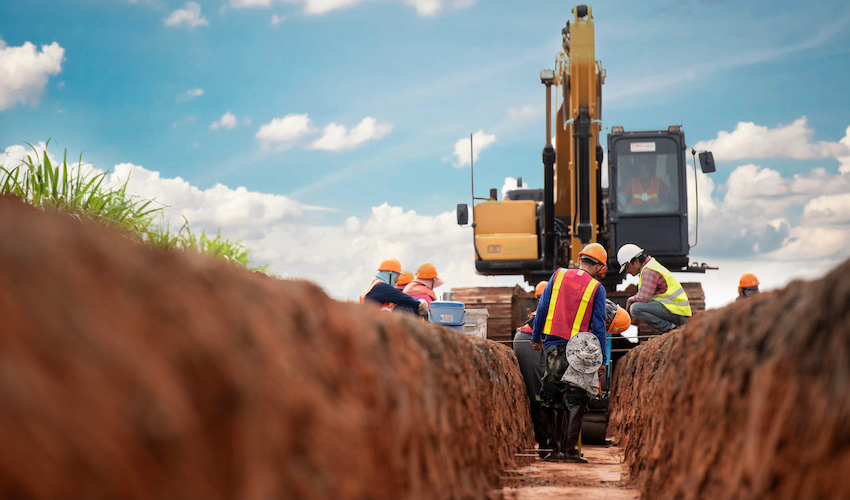Construction fleet management can be a challenging task. With so many moving parts including deliveries, vehicles, and equipment shifting in every direction on a construction job site, keeping track of individual assets can quickly become overwhelming. Not only that, the operation of vehicles and equipment introduces an added layer of risk.
With that in mind, implementing risk management procedures becomes of the utmost importance and proper protocols need to be put into place before any boots touch the ground. This guide will outline the benefits of risk management in construction, specifically as it relates to fleets and equipment.
What is risk management in the construction industry?
Risk management is the process of identifying, evaluating, and then implementing procedures to mitigate any threats to a project. When it comes to a construction project, this includes managing risks to both humans and enterprise.
Some of the most common risks in construction include safety, operational, legal, and environmental threats that can influence the overall health of a development.
Types of Construction Risks
Safety
Anyone who has visited a construction site can attest that there are safety threats at every corner. In fact, the accident rate for construction jobs is 71% higher than any other industry, and 1 in 5 employee-related deaths in the United States is due to construction work. With large equipment operations and so many vehicles in the mix, fleet managers need to be aware of the inherent safety risks posed by the vehicles and their operators.
Operational
Construction projects rely on adequate planning for success. Unexpected costs, accidents, delays, and inefficiencies can severely harm the operational health of a project. So too can equipment shortages, broken assets, and other unforeseen circumstances related to fleet and equipment health. Fleet managers need to adequately plan to ensure equipment and vehicle issues in no way impede operational fitness.
Legal
Construction projects can be fraught with legal issues. From code violations to contract disputes, they can be a legal nightmare. Beyond operational legalities, most legal costs are due to construction-related accidents that can severely derail a project. This is why it is so important for fleet managers to stay on top of safety-related risks of equipment and vehicles.
Environmental
Mother nature can be an unpredictable beast, from violent storms to earthquakes. Not only can weather wreak havoc on the actual building development itself, halting progress and delaying timelines, but weather can also damage assets including vital pieces of equipment and vehicles. For this reason, fleet managers must keep an eye on environmental concerns and their potential impact on a fleet.
How to manage risk in construction with fleet management software
As a fleet manager, risk management on a construction site can feel like an insurmountable task as there is a constant need for vehicles and equipment. As noted above, vehicle and equipment utilization comes with its own unique set of risks, from operational expenses and worker safety to driver safety and maintenance. Luckily, risks can be reduced and managed with the proper tools and implementation.
Here are the top six ways construction equipment fleet management software can help streamline overall operations while mitigating any associated risks.
-
Find construction fleet vehicles and maintain inventory
When it comes to a construction site, keeping track of vehicles can be a difficult task. Workers have various vehicle needs, from moving goods and laborers to fetching materials from suppliers. Without fleet management software in place, it would be difficult to account for a specific vehicle at any given time. Thankfully, a streamlined GPS fleet tracking solution can help fleet managers locate and keep track of vehicle movement while helping them to maintain an accurate inventory.
-
Gain context into vehicle movement
Even better than just tracking vehicles, GPS fleet tracking coupled with fleet dash cams can give managers near real-time video footage both inside and outside a vehicle. This is beneficial to not only understand where a vehicle is, but also context such as how the vehicle is being used, by whom, and why.
-
Improve driver safety
Fleet dash cams are also an invaluable tool to maintain driver safety. A dash cam powered fleet safety solution can empower workers to correct risky driving behavior while providing much-needed footage in the event of an accident. This can help both exonerate drivers and provide vital footage needed in the event of any legal disputes.
-
Ensure authorized vehicle usage
Thorough GPS fleet tracking software can also allow fleet managers to configure geofences to ensure vehicles are staying within authorized areas. Alerts can identify vehicles leaving a site without authorization, signaling possible theft, or workers checking out without permission.
Geofences are also useful for those permitted to leave a job site, making sure drivers don't make deviations from approved routes. In the event of a theft, GPS coordinates can be provided to law enforcement for stolen vehicle recovery. -
Keep track of equipment and prevent theft
Construction equipment is an incredibly costly investment. With that in mind, it is mind-boggling how often poorly secured they are. Lax measures vary from poor security at job sites to a lack of anti-theft measures and subpar equipment management.
An asset tracking solution can help fleet managers not only protect their expensive yellow iron equipment from theft but keep track of its movement and other vital equipment management processes. -
Maintain vehicle health
Lastly, keeping vehicles and expensive assets running and in prime working condition can be a challenging task alone. Without adequate management, there is no efficient way to keep track of fuel levels, battery life, recent service, and other important measures to ensure all are kept in top shape.
That’s where a great fleet maintenance solution can make all the difference. It can not only improve safety and reduce risk but reduce downtime and lower operating costs.
Contact us to learn more ways our construction risk management services can benefit your next construction project.
